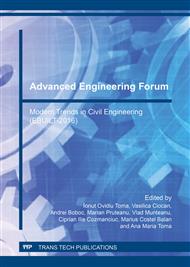p.213
p.219
p.226
p.234
p.242
p.249
p.255
p.262
p.272
Hygrothermal Behavior of Clay - Sunflower (Helianthus annuus) and Rape Straw (Brassica napus) Plaster Bio-Composites for Building Insulation
Abstract:
The aim of this experimental investigation is to study and compare hygrothermal properties of different materials based on vegetable aggregates and clay in order to prove the performance of the developed composite in the framework of BIOCOMP project. Crude earth is known to have very high capacities to regulate indoor humidity. Vegetable aggregate is characterized by high porosity leading also to very effective natural indoor climate regulators. Then, we expect the mix of these two material will to produce an insulation bio-composite with enhanced thermal and hygroscopic performance. Sunflower stem, rape straw and clay used in this investigation are considered as a very low carbon footprint because they are real local agricultural byproducts. Clay-sunflower and rape bio-composites seem to be appropriate and effective biobased insulating plasters, further investigations must be performed in order to characterize more accurately their interesting hygrothermal properties as long as the acoustical and mechanical aspects. Samples have been manufactured with four different vegetable aggregates (rape straw, sunflower bark, sunflower pith and a mix of sunflower pith and bark) at a same binder/aggregate ratio. The same clay soil is used as a binder for the four bio-composites. The thermal properties for the different bio-composites were obtained from the thermal conductivity measurements after various relative humidity, in order to evaluate the impact of the water content on the thermal parameters. For the hydraulic properties, the sorption-desorption isotherms for the four composites are obtained. The results show a significant effect of the different aggregates on the hygrothermal behavior of the bio-composite based on clay.
Info:
Periodical:
Pages:
242-248
Citation:
Online since:
March 2017
Authors:
Price:
Сopyright:
© 2017 Trans Tech Publications Ltd. All Rights Reserved
Share:
Citation:


